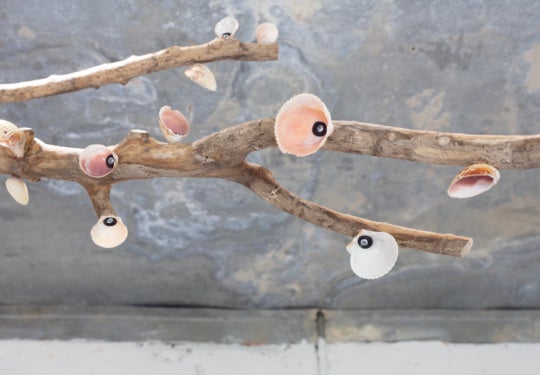One-time Georgia resident Beverly Buchanan (1940-2015) is handsomely and thoroughly remembered in “Beverly Buchanan—Ruins and Rituals,” at the Spelman Museum of Fine Art through December 2. The exhibition debuted at the Brooklyn Museum’s Elizabeth A. Sackler Center for Feminist Art earlier this year. There it suffered from the center’s curious layout, in which narrow galleries wrap around three sides of the permanent installation of Judy Chicago’s The Dinner Party. Disappointingly, it included only a modest number of Buchanan’s best-known works — her shack sculptures — and squeezed those together on two platforms (perhaps meant to make a community but limiting the viewer’s ability to examine them individually).
Spelman added a few shack sculptures and a number of paintings to Brooklyn’s checklist. But probably equally important is the generous openness of the museum’s exhibition space, which allows sufficient distance for viewers to appreciate the vigorous gestures of the paintings, and sufficient elbow room to examine all sides of the sculptures. The result is a beautiful and satisfying exhibition.
Buchanan’s whole life is played out, documenting her training and her work as a public health educator in New Jersey before she finally yielded to her lifelong urge to make art. Her notebooks, photographs and other archival material is included. Not all of it is engrossing, but it’s admirable that it’s treated with such respect. Her early cement sculptures are blocky accumulations that are interesting in relation to Post-Minimalism and Land Art of the same time (the ’70s), but they lack the vitality of her later work. She also made site-specific outdoor sculptures in the South in the ’80s, some essentially private memorials to racial tragedies. These give her work a moral depth and also, it has been noted, clearly separate her from untutored or folk art with which she is sometimes mistakenly identified. A more visually powerful outlier in the show is a large orange abstract painting related to textures in the real world, rather than images.
The shacks were inspired by real places she photographed as well as an uncle’s photographs of Southern tenant farm communities in the 1920s and ’30s. But they are presences of their own, not illustrations. One thing that catches the eye is that they are an intermediate scale—not the miniaturization of railroad or architectural models, and not the precision of those, either. Instead the shacks are made of found materials roughly cut to size so that they strongly evoke the improvisational nature of the rural Southern originals—gaps between boards, used tin for roofs, raised off the ground on blocks of some sort. This scale and the casual shaping give the shacks a dynamism and a sculptural presence of their own.
While the shacks do not specifically suggest the identity of their inhabitants, Buchanan was always interested in background stories—she sometimes referred to them as legends—and perhaps it’s her thinking about these stories (which are sometimes recounted) as she made the objects that gives the best of them an almost numinous aura. There is a single figurative sculpture, an anonymous skinny woman in a patchwork dress and a broad-brimmed hat, life-size and also made of scraps and refuse.
The paintings often share the subject matter—shacks or collections of them, usually executed in oil pastel and mostly in deep, saturated colors. These have a satisfying solidity and fullness. Even unarticulated ground is such a dense red that it does not provide a neutral background but seems to push the depicted objects or figures forward in space. That’s true of two of the three paintings that are straight ahead as the viewer enters the exhibition. The third work there offers other alternatives: a vigorous scribble and use of photographic images of herself. All three stand out spectacularly against a wall painted deep blue.
In a 1982 magazine interview, Buchanan said, “A lot of my pieces have the word ‘ruins’ in their titles because I think that tells you this object has been through a lot and survived—that’s the idea behind the sculptures — it’s like ‘Here I am; I’m still here!’” The same could be said of the artist.
Janet Koplos is a critic, educator and curator based in St. Paul, Minneapolis. She is a contributing editor at Art in America, where she was also senior editor from 1990 to 2008. She is the co-author, with Bruce Metcalf, of Makers: A History of American Studio Craft (2010, University of North Carolina Press).




